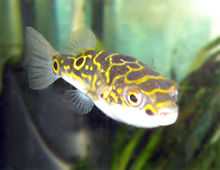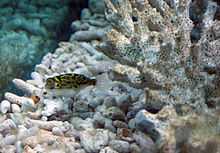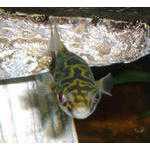Tetraodon biocellatus
| Figure 8 pufferfish | |
|---|---|
 | |
| Conservation status | |
| Scientific classification | |
| Kingdom: | Animalia |
| Phylum: | Chordata |
| Class: | Actinopterygii |
| Order: | Tetraodontiformes |
| Family: | Tetraodontidae |
| Genus: | Tetraodon |
| Species: | biocellatus |
| Binomial name | |
| Tetraodon biocellatus Tirant, 1885 | |
Tetraodon biocellatus, commonly the figure 8 puffer or eyespot puffer, is a pufferfish found in freshwater in Southeast Asia. It is known from the lower reaches of the Mekong (Cambodia), the Peninsular Malaysia as well as Borneo (Sarawak, Kalimantan).[1]
Characteristics
Figure 8 puffers grow to about 8 cm (3.1 in) long.[2] They are colourful fish, with greenish yellow patterns on their backs. These patterns vary greatly from fish to fish, but the markings either side of the caudal fin resemble the number eight, or eye-spots (earning the species another common name as 'Eye-spot puffer'). Figure 8 puffers are relatively peaceful among Tetraodontidae, and have been kept successfully with other fish such as bumblebee gobies and mollies, but as with all pufferfish there is a risk that tankmates will not be tolerated.
Like all members of the Tetraodon family, the figure 8 puffer is capable of inflating itself with water or air when stressed or otherwise frightened.
In captivity

In captivity, figure 8 puffers require a 15 US gallon tank with temperatures between 24°C and 28°C. They are sensitive to nitrites and nitrates and must be introduced into a fully cycled aquarium. Over-filtration is recommended as well as frequent partial water changes. Water pH will reflect the brackish environment to which these fish are best suited; the addition of marine salt will buffer the pH to a range between 7.8 and 8.3. A salinity of between 1.005 and 1.008 specific gravity (S.G.) has been found to increase the lifespan of this species to as long as 15 years. However, this fish is found in fresh water in the wild.[3] As with all puffer fish, they require a complex aquarium set up consisting of many nooks and cranies. This helps figure 8 puffers to behave as they would in nature, and reduce boredom.
Diet
Pufferfish are classed as molluscivores and feed mainly on benthic organisms which may include mussels, cockles, oysters and krill, though some puffers will take other foods, such as flake, it is not recommended that their primary food is flake. Their teeth, a beak formed from two plates, are capable of crushing shells in order to feed on prey. In captivity many fishkeepers feed snails as a substitute for the aforementioned foods as snails help keep the beak trim; it would otherwise be susceptible to overgrowth.
References

- ↑ 1.0 1.1 Vidthayanon, C. (2012). "Tetraodon biocellatus". IUCN Red List of Threatened Species. Version 2012.2. International Union for Conservation of Nature. Retrieved 11 March 2013.
- ↑ Froese, Rainer and Pauly, Daniel, eds. (2013). "Tetraodon biocellatus" in FishBase. March 2013 version.
- ↑ The Puffer Forum, http://www.thepufferforum.com/forum/ug.php/v/PufferPedia/Brackish/T_Biocellatus/ (Retrieved 25 July 2007)
Bibliography
Ebert, K. (2001), The Puffers of Fresh and Brackish Water, p 19. Aqualog, ISBN 3-931702-60-X.
